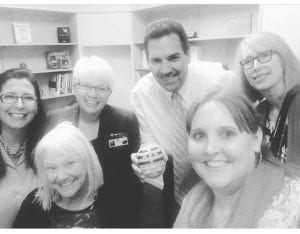Bee-Bots Dancing to bring “Computer Science For All” to young learners
Lesson from “No Fear Coding” by Heidi Williams
The first robotic bee for all students should be the Bee-Bot.
 Practice math skills by coding a floor robot with 4 simple commands. Building Connections & Understanding + Real-world Application is a mathematics practice to prepare students to use patterns and relationships. Bee-Bots can help build those connections! Come Dance with the Bees and see how you can use these and other unplugged activities to build computational thinking skills in the lower grades.
Practice math skills by coding a floor robot with 4 simple commands. Building Connections & Understanding + Real-world Application is a mathematics practice to prepare students to use patterns and relationships. Bee-Bots can help build those connections! Come Dance with the Bees and see how you can use these and other unplugged activities to build computational thinking skills in the lower grades.
People often ask me if I know the secret of success and if I could tell others how to make their dreams come true. My answer is, you do it by working. I suppose my formula might be: dream, diversity – and never miss an angle. – Walt Disney “The Quotable … it was all started by a mouse.”
These activities are just a start to give you 90 degrees angles to build diversity and dreams in your classroom. Download the activity details here.
Practice is KEY to mastery:
- ACTIVITY ONE GOAL: PLAY – Have fun with the Bee-Bot.
- ACTIVITY TWO GOAL: CONTROL – Master move forward command.
- ACTIVITY THREE GOAL: CONTROL – Master left & right commands.
- ACTIVITY FOUR GOAL: CONTROL – Spell CVC words – backward & pause commands
- ACTIVITY FIVE GOAL: MOVEMENT – Program the Bee-Bot to perform a line dance.
- ACTIVITY SIX GOAL: CHALLENGE – Robotic spelling bee – code 1-letter to 7-letter words
I am the busy “B” looking for bugs in the system.
I sometimes sting when mad, but prefer to catch a fly with honey.
The Bee-Bot is the best tool available to start a learner on the road to mastering computational and critical thinking skills. This robot makes the essential skill of decision making easy with just four movement commands and three control commands. Reducing the complexity of a problem builds the process of learning how to solve problems. In addition to problem solving, adding to the introduction to computer science practices are creativity, collaboration, communication and the persistence needed to tackle challenges. Students can use the Bee-Bot to easily practice pattern recognition and generalization as well as algorithm development. Once students have mastered these computer science concepts they can move on to the harder computational thinking skills.
The best lessons are those the students create that fit their mindset. The teacher provides a few examples and the questions. The best way to learn how to integrate the Bee-Bot is hands-on sitting on a floor and watching kids play and asking questions. And then connect the questions to current curriculum concepts. Always do pair programming. See video on code.org studio.code.org/s/course1/stage/3/puzzle/1 or search pair programming for more resources.
Professional Development
- We-Teach CS Summit 2016
- Spring Branch ISD Houston 2013 PD
- Texas Computer Education Association 2013 Robotics Academy
- SWE InventIT – CodeIT 2012 workshop
Examples
 The Bee-Bot with the arrow represents the
The Bee-Bot with the arrow represents the